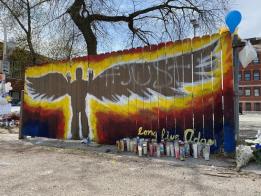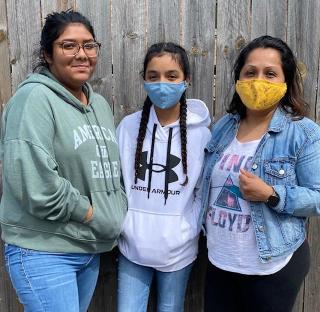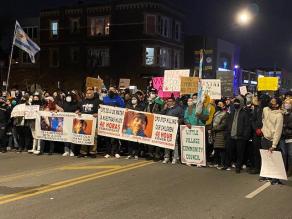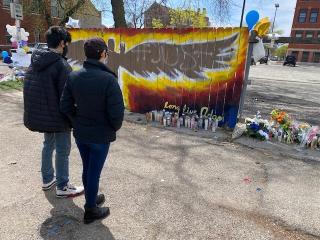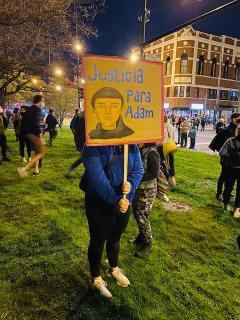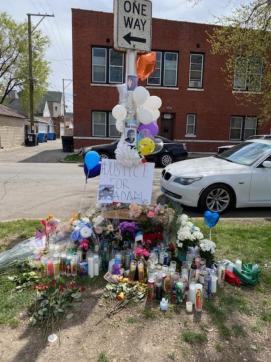A steady stream of visitors came and went this weekend to an alley in “La Villita”, as the neighborhood of Little Village is affectionately known by its mostly Mexican, Mexican-American residents; to the site of the final moments of Adam Toledo’s life.
Many of the mourners at the makeshift memorial were parents with their children who paid their respects by leaving candles, flowers, and messages at the very spot where the 13-year old died.
They prayed at the mural, a cutout of Adam with his hands up and angel wings memorializing the instant when he was shot and killed by a Chicago police officer.
Their fixed stare lost in thought over the tragedy that happened there just weeks ago, and the violence many of them know all too well.
“I don’t want my son growing up here”, said Erica Sanchez as she held her 3-year old son. Sanchez was born and raised in Little Village and graduated from the high school just a few feet away from the scene of the shooting.
She, like other visitors, was compelled to come after seeing the police shooting video. “It was shocking”, Sanchez said. “It reminded me a lot of friends who have died because of violence.
Dulce Canada got emotional as she described how she felt after watching the video. “Police acted too fast, too soon”, she said in Spanish.
“I don’t feel safe”, she whispered looking at her two daughters, Jennifer 24 years old, and Valeria 12 years old.
It’s a sentiment that 15-year old Alan shares. “They’re supposed to protect us”, he said of the police in Spanish as he studied the mural with his mother, Delia Roman by his side.
A History of Racial Abuse
The release of Officer Eric Stillman’s body camera footage Wednesday set off a fresh round of angry protests against the Chicago Police Department for what demonstrators said is a history of racial abuse.
The shaky video of the March 29 fatal encounter shows Stillman chasing Adam down a dark alleyway. The officer screams “Stop right now!” Then tells him to drop his gun. “Hands. Show me your hands. Drop it. Drop it”, he continues. As Adam turns and lifts his hands, a single shot is fired and he collapses to the ground.
Thousands gathered Thursday night in Logan Square in response carrying signs, many of them reading, Justice For Adam” and chanting, “From the West side to the South – CPD, We want you out!” and “Hands up, don’t shoot!” reminiscent of 2015 protests over the police shooting of Mike Brown in Ferguson, Mo..
“So if you put your hands up, they shoot. If you put your hands down, they shoot,” state Rep. Edgar Gonzalez said from the floor of the Illinois House on Friday. “If you walk, you run, you hide, you sleep, you do exactly as they say, they still shoot – What the hell are we supposed to do?” Gonzalez’s district includes the block where the shooting happened.
“Police kill Hispanics-Latinos at a rate six times higher than white people”, said González Van Cleve in an interview with NBC News. He is the author of “Crook County: Racism and Injustice in America’s Largest Criminal Court,” delving into racial bias in Chicago’s legal system.
A practice of abuse favoring the safety of police over the public has festered mistrust with Hispanic-Latino residents like Sanchez. “Police only use the power of their guns in solving problems”, said Sanchez of the severed relationship with law enforcement. “People don’t want to call 911 because they don’t get the help they need from the police.
Culture of Violence
Adam Toledo’s brief life and violent end is a reflection of a reality experienced by Black and brown youth in Chicago.
Chicago police statistics reveal the first three months of 2021 have so far been the deadliest in the city in four years.
131 slayings were recorded, a 34% increase over the same period last year. The number of total shooting victims, including those killed by gunfire, also saw a spike of 706, a 43% increase.
Neighborhoods on the South and West side hurting from poverty and disinvestment historically see the most violence.
“I feel insecure”, said Alan. The teenager remembered a shooting that happened right outside his home. “Gangs are everywhere.”
“I tell my daughter to pull back her hoodie whenever we are driving”, says Canada of her teenage daughter, Valeria. “I am afraid she will be mistaken for a gang member and be a target.”
Chicago Police records show as many as 70 active and inactive gangs in the city, although critics question the validity of the information that lists about 135,000 Chicagoans as members.
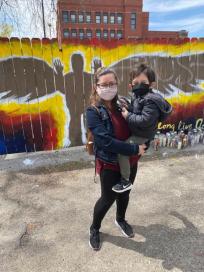
Sanchez who has had a gun aimed at her head said Adam’s case is symptomatic of a larger problem. “People ask where were the parents? Why was he out in the middle of the night? Why did he have a gun?” She said the question should be what type of environment makes children vulnerable?
“If you weren’t raised in this neighborhood, then you don’t understand the needs”, criticized Sanchez of the victim-blaming. “Adam might not have been perfect, but there was no need for him to die that way.”
The perception that victims are in any way responsible for the actions of offenders is core to a prejudiced culture of violence that strips authority of any accountability.
A Cook County prosecutor who accused Adam of having a gun when he was shot to death is now under investigation.
“An attorney in our office failed to fully present the facts surrounding the death of a 13-year-old boy,” Cook County State’s Attorney Kim Foxx spokeswoman Sarah Sinovic said in a statement. The video speaks for itself.” The prosecutor has been put on leave.
That type of misinformation is not an aberration, but more damning evidence of a contaminated self-serving system that is often proliferated by a homogenous media more concerned with offending the privileged than fair and accurate reporting.
Changing the Rules of Engagement
Governor J.B. Pritzker, Chicago Mayor Lori Lightfoot, and many other political and community advocacy leaders vowed to change a system that did little for Adam.
In a statement, Representative Jesús “Chuy” García, D-Ill., a resident of Little Village said, “Whatever the circumstance, we must never normalize the shooting of a child by police. We failed Adam, as we have failed so many other young people in our country.”
Severe criticism of the Chicago Police Department prompted Mayor Lightfoot to once again ask that the department create a better policy for foot chases she said too often prove dangerous to suspects, the police, and the public. “I refuse to treat this as just business as usual,” Lightfoot said.
Adam’s killing has kindled movements against racial injustice and excessive use of force by police. Traditional policing often escalates tense situations making people of color vulnerable to violence because of systemic racism.
“He had his hands up”, said Alan about Adam surrendering to Officer Stillman. “Police often make matters worse.”
Stillman’s aggressive approach put him in a vulnerable position where he was running alone in a dark alley at night with poor visibility and cover. Reform advocates say de-escalation tactics must be adopted to minimize violence to police and suspects. Under such policies, Adam would never have been pursued.
There is also a history of distrust of police in communities of color like Little Village due to the disproportionate number of arrests, jail time, and violence.
“Police need better training to deal with Hispanic and Black communities”, said Sanchez. She blamed a lack of cultural competency.
Language and cultural barriers can widen the divide between law enforcement and the public they serve. But having a diverse police force that reflects the community might not be enough for critics who contend officers should live where they work as a way to have skin in the game.
“I think law enforcement is a world apart from the needs of every community of color”, says Katya Nuques, Executive Director, Enlaces Chicago – a community focused organization in Little Village with programming focused on violence prevention. “Unfortunately, I think cops in this country are trained to serve in white/afluent neighborhoods, not in communities of color. The disconnection is abysmal, and therefore we need decades of training and a whole generation of police officers who enter the force under different policies, training, and practices, before we see a fundamental difference.”
“We also must commit to substantive, sustained investments in Brown and Black communities. Let’s put a laser focus on creating real futures for young Brown and Black boys”, read the Illinois Latino Agenda statement on Adam Toledo.
The coalition of Hispanic-Latino leaders said that reform must include economic empowerment. “While we proactively work to eradicate racist policing, we as a society need to apply the same force to expanding opportunities for young men of color to excel in school, the professional world, and life.” Resources that residents of La Villita who live in fear, agree their children need in order to escape the violence gripping their neighborhood.



